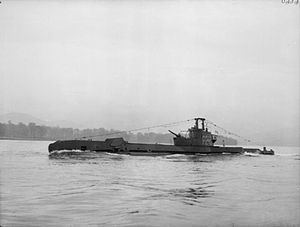Name HMS Scotsman Laid down 15 April 1943 Launched 18 August 1944 Test depth 107 m Beam 7.16 m | Ordered 20 December 1941 Commissioned 9 December 1944 Construction started 15 April 1943 Length 66 m Draft 4.47 m | |
 | ||
Fate broken up November 1964 | ||
HMS Scotsman was a S-class submarine of the third batch built for the Royal Navy during World War II. She survived the war and was sold for scrap in 1964.
Contents
Design and description
The third batch was slightly enlarged and improved over the preceding second batch of the S-class. The submarines had a length of 217 feet (66.1 m) overall, a beam of 23 feet 9 inches (7.2 m) and a draft of 14 feet 8 inches (4.5 m). They displaced 814 long tons (827 t) on the surface and 990 long tons (1,010 t) submerged. The S-class submarines had a crew of 48 officers and ratings. Scotsman had thicker hull plating which increased her diving depth to 350 feet (106.7 m).
For surface running, the boats were powered by two 950-brake-horsepower (708 kW) diesel engines, each driving one propeller shaft. When submerged each propeller was driven by a 650-horsepower (485 kW) electric motor. They could reach 15 knots (28 km/h; 17 mph) on the surface and 10 knots (19 km/h; 12 mph) underwater. Scotsman could carry more fuel than most of the third batch boats and had a range of 7,500 nautical miles (13,900 km; 8,600 mi) on the surface at 10 knots (19 km/h; 12 mph) and 120 nmi (220 km; 140 mi) at 3 knots (5.6 km/h; 3.5 mph) submerged.
Scotsman was armed with six 21-inch torpedo tubes in the bow. She carried six reload torpedoes for a grand total of a dozen torpedoes. Twelve mines could be carried in lieu of the torpedoes. The boat was also equipped with a 4-inch (102 mm) deck gun.
Construction and career
HMS Scotsman was built by Scotts, of Greenock and launched on 18 August 1944. She survived the Second World War and in 1953 took part in the Fleet Review to celebrate the Coronation of Queen Elizabeth II. Scotsman was decommissioned in 1961 and in spring 1964 was scuttled off the Isle of Bute so she could be salvaged as part of a training exercise. She was raised in June 1964 and sold to the West of Scotland Shipbreaking Company, arriving at Troon on 19 November 1964 for breaking up.
